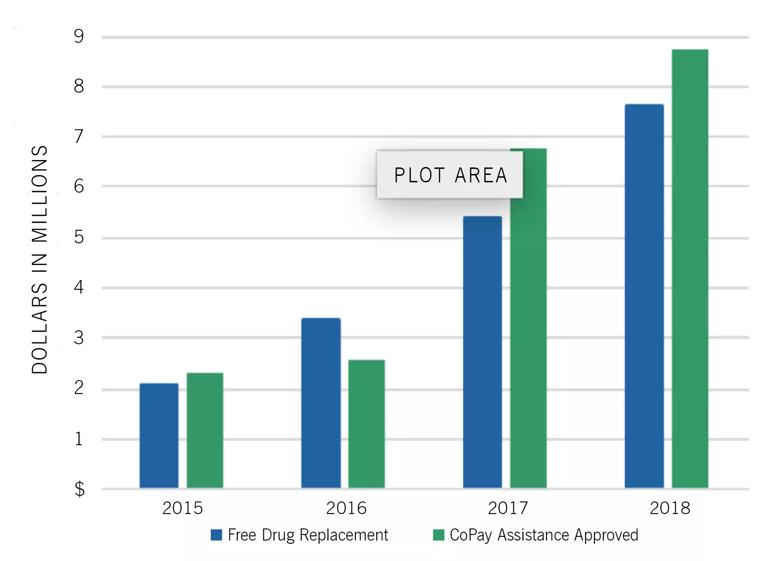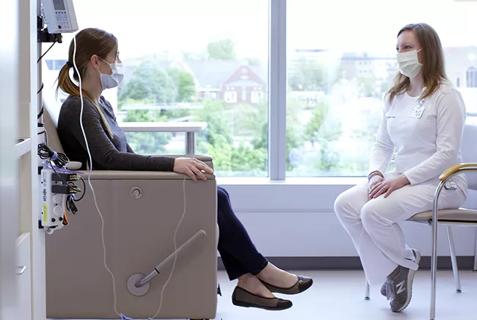Advertisement
Reducing uncollectible revenue, financial burden

Hardly a single aspect of life isn’t turned upside down by a cancer diagnosis. Beyond absorbing the impact of the news and its implications, patients and families have new learning to take in, appointments to keep, and perhaps childcare and work leave to arrange.
Advertisement
Cleveland Clinic is a non-profit academic medical center. Advertising on our site helps support our mission. We do not endorse non-Cleveland Clinic products or services. Policy
With the imperative of seeking a cure at the forefront, the financial aspects of treatment are sometimes an afterthought. However, patients soon feel the financial impact. A 20% coinsurance on a high-dollar chemotherapy can cost $5,000 or more per treatment.
An initiative at Cleveland Clinic Cancer Center is helping curb uncollectible revenues and lessen the financial burden for patients. It began in 2016 with the creation of a financial navigator position, a role dedicated solely to helping cancer patients.
Today, Cleveland Clinic Cancer Center’s seven financial navigators are making the financials work better for cancer patients and their providers. In the past three years, the dollar amount approved through copay assistance has increased by 70%, and the funds collected to pay patients’ out-of-pocket costs have doubled. Through tapping resources on patients’ behalf, the free-drug value received by patients has risen 55%.

Cleveland Clinic Cancer Center’s Reimbursement Manager, Melissa Monak, presented a poster on the initiative at the 2019 American Society of Clinical Oncology Annual Meeting.
Her team members are zealous in finding solutions for patients, she says.
Advertisement
“Studies show cancer patients are twice as likely to declare bankruptcy,” says Monak. “We want to see our patients get the treatment they need without this huge burden. If there is a way we can get those services paid for them, not only are we helping with our revenue collection, but helping improve patient outcomes by lowering their financial stress.”
Beginning soon after diagnosis, a financial navigator works with the patient and family to address common sources of confusion about insurance and billing.
“When patients receive bills for radiology services, oncologists, labs, drugs, administration of drugs and psychologists, it quickly becomes daunting,” says Monak. “Unless you deal with this every day, it’s difficult to navigate and understand what’s expected. A lot of people think they have good insurance and do not realize what their out-of-pocket expense could be.”
Once the educational foundation is laid, financial navigators work closely with social workers to begin the creative work of determining how to lessen the family’s financial burden. The team works with foundations, pharmaceutical companies, community organizations and charities for patient assistance as well as living expenses, such as mortgage, food, child care and utility payments.
Solutions are rarely routine or permanent, however. Often it is a matter of scouring the internet and revisiting websites daily to capture offers when they become available.
Housing is another costly necessity for out-of-town patients. Recently a financial navigator found an independent living facility with apartments for families and patients available for $35 a night. “Radiation therapy is every day for 4-6 weeks,” Monak says. “Lower cost accommodations make a huge difference for these patients.”
Advertisement
Transportation can be another logistical and financial challenge. Cleveland Clinic Cancer Center is working with philanthropic organizations and Uber to offer low-cost rides to treatment sessions.
“Part of the Oncology Care Model (OCM) is making sure we inform patients of what the estimated out-of-pocket costs are so they aren’t surprised by them,” says Monak. “But that has only been a jumping-off point for us. We work beyond the required number-crunching and communication. It’s the life-changing help we can provide that makes our jobs so fulfilling.”
Cleveland Clinic Cancer Center has been able to comply with the OCM out-of-pocket expense metric for all treatment patients. In 2017, soon after the financial navigator position was created, they conducted outreach to 44% of cancer patients. This rose to 98% by April 2018.
One particular incident brings it all home for Monak. “I was talking with a patient who refused to undergo chemotherapy because she didn’t want to put her family at financial risk. Her husband, on the other hand, said, ‘I don’t care what it costs. I want her as long as I can have her.’ Fortunately, we were able to find copay assistance for her, and she continued the treatment.”
Advertisement

Clinical trial to assess the value of nutritional, physical therapy and social supports prior to preoperative chemotherapy

Research demonstrates improved overall survival for patients receiving comprehensive treatment for breast cancer in addition to radiation or surgical intervention for brain cancer

Palliative and Supportive Care Teams offer comprehensive care to improve the lives of patients facing cancer

Newer medications pivotal for improving gastrointestinal symptoms in patients with cancer

Helping patients with cancer struggling with depression, anxiety and other mental health issues

Majority of 1,000 patients seen in 2022 discharged home

Identifying the underlying cause key to successful treatment

Patient resources promote healthy living, management of late and long-term side effects